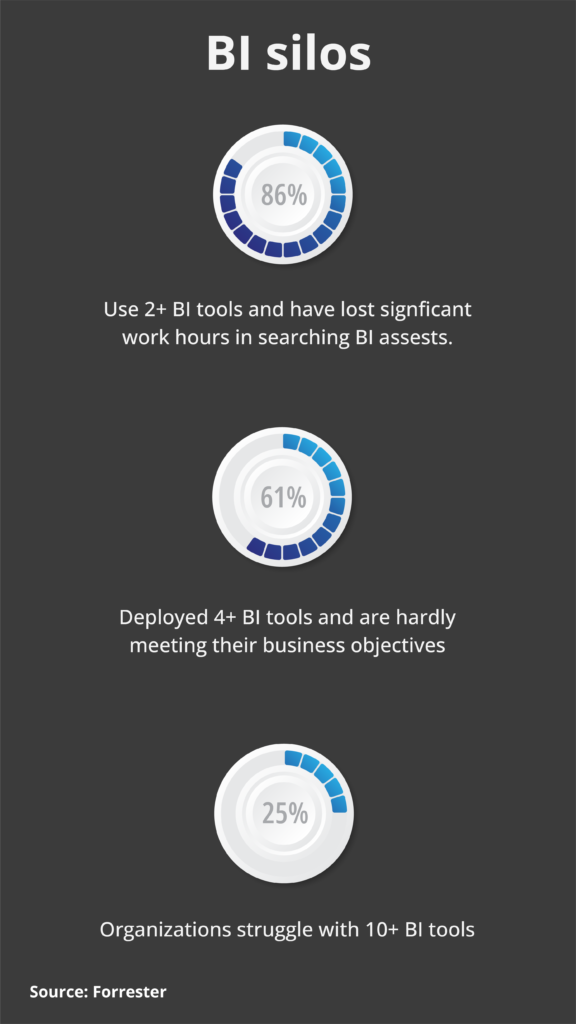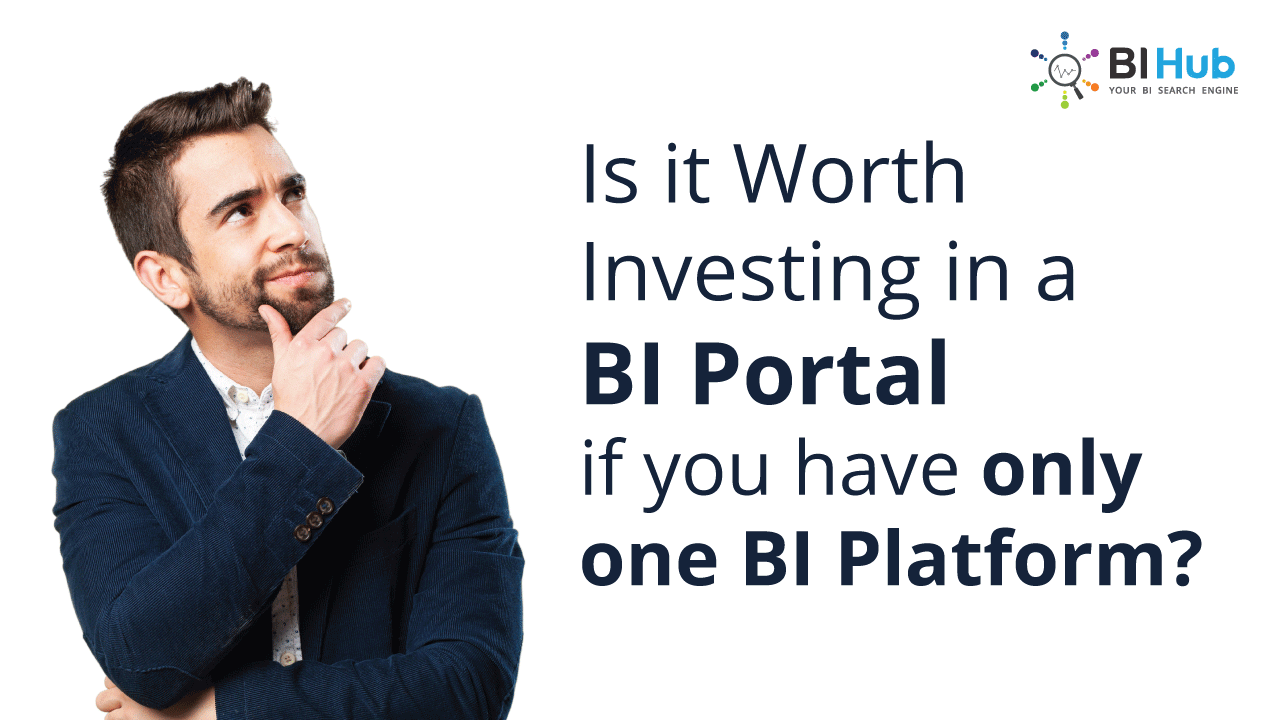Many enterprises are confused with dealing the unsatisfactory reality of legacy BI systems. We must accept the reality that the legacy BI systems that support day-to-day business activities will remain in place for the foreseeable future. However, because a sizeable component of these systems is used to support daily business operations, it is difficult to completely decommission and replace them. It’s not as simple to just rip-and-replace a legacy BI environment in favor of a newer, shinier technological platform for a variety of reasons, one of which being greater business risk.
While companies continue to invest time and money in conventional BI systems, 47% cite a growing need to integrate with modern systems to satisfy business expectations. Nearly 97% of all gathered reports are simply archived in these legacy BI platforms and never used again. Furthermore, much of it is obsolete and superfluous, adding little to no value to the organization. However, by giving your legacy BI tools a modern life, you can alleviate existing issues.
So, how do you create a new BI ecosystem and take advantage of integrating multiple BI platforms while retaining the benefits of legacy BI platforms without causing any IT involvement and interruption? Don’t worry, this blog will be your comprehensive guide.
You must strongly believe that in order to gain a new technological platform, you don’t need to disturb the entire IT environment. After spending money and time on your legacy program, a complete rewrite makes no sense, right? What if we tell you that it is possible to adopt newer technology without having to start from scratch? You can improve your existing application without having to construct a new one by using many industry solutions and a ready-made architecture called BI fabric.
Why is this modernization happening?
Basically, BI fabric entails bringing your enterprise BI reports from legacy and modern BI platforms (both on-premises and in the cloud) to a single advanced new system that enhances business intelligence. This can greatly boost employee satisfaction while also improving business decision-making efficiency. Integrating on-premises and cloud platforms allows for a new report management and consolidation module that would otherwise be hard to provide. This facelift boosts the ability to adapt to any unanticipated advancement of technology.
Why has BI modernization and BI fabric become crucial for all enterprises?
Competitive advantage
54% of firms that provide IT services state that one of the most challenging elements is integrating new technologies. The integration of a new solution into a current BI environment has become a concern on the path to digital transformation. Fortunately, legacy-modern BI system integration aids in the management of a light product that provides a competitive edge.
Reliability and growth
Newer technologies offer improved performance as well as a more consistent and smoother workflow. Advancement has become crucial component in this competitive market, and it is high time to take advantage of legacy systems with modern solutions. Furthermore, modern BI solutions improve functionality and governance while reducing security risks.
Recover buried reports
As previously stated, 97 percent of reports in older systems are lost and forgotten. Unlocking the value of your data can help you enhance your business processes.

Futuristic
Every industry requires a specific process of report management. Outdated legacy BI systems cannot ensure this strict flow and block changes. You leave a larger window for future opportunities by adapting your IT environment to fit into nimble and cutting-edge technological developments.
Be market-driven
Every business intends to be modern and up to date, which is difficult to achieve if you continue to use obsolete BI platforms without integrations. Embracing innovation will enhance your company’s image and may even attract investors. Integration is significantly less invasive and costly than a total system replacement.
Common challenges
Legacy technologies have a rigid manual integration structure that entails time-consuming operations. It has a restricted view of data flow between on-premises and cloud apps. Data security in integrating traditional BI systems is significantly high, and data transit has a significant amount of latency. While employees are accustomed to using legacy systems, the inflexibility and continual care these technologies require will hinder business progress.
How to integrate all Legacy BI systems with modern many?
Since these legacy BI systems help us find some relevant analytics content, and it is just not financially or logically feasible to get rid of them completely. However, when they undergo digital transformations, the most astute businesses know this and seek to effectively balance both worlds. The end goal is to create cost-effective legacy system connections with current applications without causing interruption, and businesses who do this can preserve their legacy systems while freely embracing newer BI solutions.
There is more than one way to connect legacy and modern BI systems, but we’ll focus on the three basic ones with the one ready-to-go like BI fabric.
Create a custom integration
As your BI ecosystem evolves, the question becomes how often you’ll need to create new integrations. Companies that do this want to fully own the solution and have a strong applicant pool of programmers who can develop code in legacy programming languages and customise it to their specific needs. However, from the coding involved to the time it takes to maintain a proprietary integration in-house, this is a significant undertaking.
API adoption
APIs, as one of the most prevalent legacy BI system integration types, expose functions of your legacy software to outside integration and simplify the process. APIs provide much-needed flexibility while also improving performance. This method necessitates the use of developers, which means you are ultimately responsible for any necessary adjustments. While this does not necessitate a significant financial investment up front, it does take time to establish integrations. API-centric integrations are also continually being developed and maintained, so you’ll need some developers who can keep up with these ever-changing APIs.
Readymade Integrations – BI Fabric
Instead of going through the time-consuming process of integration on your own, you can subscribe to a ready-made solution. Some businesses provide a straightforward solution for smooth integration, hence resolving the issues with legacy BI infrastructure. Ready to go solutions like BI fabric architecture is provided by BI Hub and it is a single integration platform designed to reliably connect your legacy BI system with modern BI platforms., without the fear of business disruption. Its flexible deployment choices are also tailored to your firm’s needs, allowing your IT personnel to focus on business growth rather than the complexity of managing integrations.
Lastly, a few words adopting new solutions and technologies without giving a thought and evaluation will result in a highly complicated BI ecosystems that will require an immediate revamp. Therefore, it’s critical to properly examine your obsolete systems and determine whether or not they need to be replaced. You should consult BI experts to achieve your objectives and avoid unintended outcomes that could render your initial system upgrade plan ineffective. Their knowledge will ensure a thorough plan for legacy system integration and help you get closer to success.
Reach out to us if you would like to see a BI Hub demo and how BI Hub can act as an Enterprise BI Management tool for your organization.


